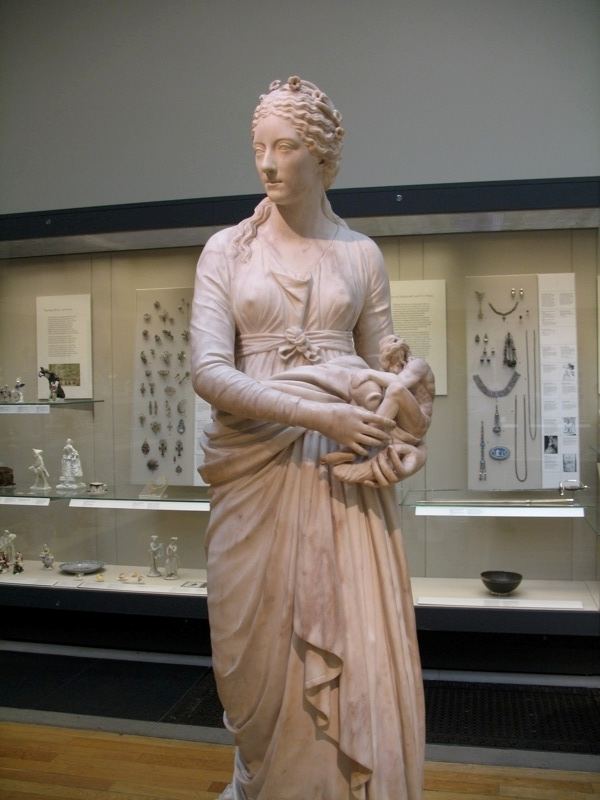Name Anne Damer | Books Belmour: A Modern Edition | |
 | ||
Died May 28, 1828, Mayfair, London, United Kingdom | ||
Anne Seymour Damer, née Conway, (8 November 1749 – 28 May 1828) was an English sculptor.
Contents

Life

Anne Conway was born in Sevenoaks into an aristocratic Whig family; she was the only daughter of Field-Marshal Henry Seymour Conway (1721–1795) and his wife Caroline Bruce, born Campbell, Lady Ailesbury (1721–1803), and was brought up at the family home at Park Place, Remenham, Berkshire.

In 1767 she married John Damer, the son of Lord Milton, later the 1st Earl of Dorchester. The couple received an income of £5,000 from Lord Milton, and were left large fortunes by Milton and Henry Conway. They separated after seven years, and he committed suicide in 1776, leaving considerable debts. Her artistic career developed during her widowhood.

Anne was a frequent visitor to Europe. During one voyage she was captured by a privateer, but released unharmed in Jersey. She visited Sir Horace Mann in Florence, and Sir William Hamilton in Naples, where she was introduced to Lord Nelson. In 1802, while the Treaty of Amiens was in effect, she visited Paris with the author Mary Berry and was granted an audience with Napoleon.
From 1818, Anne Damer lived at York House, Twickenham. She died, aged 79, in 1828 at her London house, No. 27 Upper Brook Street, Grosvenor Square. She was buried in the church at Sundridge, Kent, along with her sculptor's tools and apron and the ashes of her favourite dog.
Works
The development of Anne Seymour Damer's interest in sculpture is credited to David Hume (who served as Under-Secretary when her father was Secretary of State, 1766–68) and to the encouragement of Horace Walpole, who was her guardian during her parents' frequent trips abroad. According to Walpole, her training included lessons in modelling from Giuseppe Ceracchi, in marble carving from John Bacon, and in anatomy from William Cumberland Cruikshank.
During the period 1784–1818, Damer exhibited 32 works as an honorary exhibitor at the Royal Academy. Her work, primarily busts in Neoclassical style, developed from early wax sculptures to technically complex ones in works in terracotta, bronze, and marble. Her subjects, largely drawn from friends and colleagues in Whig circles, included Lady Melbourne, Nelson, Joseph Banks, George III, Mary Berry, Charles James Fox and herself. She executed several actors' portraits, such as the busts of her friends Sarah Siddons and Elizabeth Farren (as the Muses Melpomene and Thalia).
She produced keystone sculptures of Isis and Tamesis for each side of the central arch on the bridge at Henley-on-Thames. The original models are in the Henley Gallery of the River and Rowing Museum nearby. Another major architectural work was her 10-foot statue of Apollo, now destroyed, for the frontage of Drury Lane theatre. She also created two bas reliefs for the Boydell Shakespeare Gallery of scenes from Coriolanus and Antony and Cleopatra.
Damer was also a writer, with one published novel, Belmour (first published on 1801).
Personal life
Damer's friends included a number of influential Whigs and aristocrats. Her guardian and friend Horace Walpole was a significant figure, who helped foster her career and on his death left her his London villa, Strawberry Hill. She also moved in literary and theatrical circles, where her friends included the poet and dramatist Joanna Baillie, the author Mary Berry, and the actors Sarah Siddons and Elizabeth Farren. She frequently took part in masques at the Pantheon and amateur theatricals at the London residence of the Duke of Richmond, who was married to her half-sister.
A number of sources have named Damer as being involved in lesbian relationships, particularly relating to her close friendship with Mary Berry, to whom she had been introduced by Walpole in 1789, and with whom she lived together in her later years. Even during her marriage, her likings for male clothing and demonstrative friendships with other women were publicly noted and satirised by hostile commentators such as Hester Thrale and in the anonymous pamphlet A Sapphick Epistle from Jack Cavendish to the Honourable and most Beautiful, Mrs D— (c.1770).
A romance between Damer and Elizabeth Farren, who was mentioned by Thrale, is the central storyline in the 2004 novel Life Mask by Emma Donoghue.
